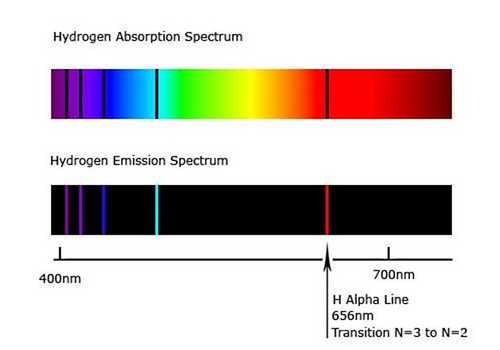The State of Physics in the 900 '
At the beginning of the twentieth century, physics was in full swing. After the invention of the spectroscope made by Fraunhofer (1814) and the discovery of absorption lines, dark lines, visible both in the spectra of sunlight and stellar light and in the light reflected from the surface of the Moon and some other brighter planets, the studies by the Kirchhoffs and Bunsen quickly led to the discovery and study of emission lines in the light spectra of chemicals (Fig. 1).

 |
Fig. 2 |
Electromagnetic waves or how many of light?
The Maxwellian vision of the world, in addition to providing in a unified electromagnetic key an accurate explanation of all the electrical and magnetic phenomena hitherto seen as separate, described visible and invisible light with a pair of reciprocally induced oscillating electric and magnetic waves (Fig. 3) synchronous at a certain frequency with a propagation speed in vacuum of about 300,000 kilometers per second.
The explanation of the black body spectrum proposed by Planck (Fig. 4), on the other hand, required to accept for no apparent reason that the exchanges of energy and momentum between electromagnetic radiation and matter in equilibrium at a certain kelvin temperature, took place in a discrete way, therefore not for any value of energy as Maxwell's theory would have it, but for multiples of the values of energy and momentum proportional to the frequency of the wave. In the electromagnetic theory, on the other hand, the energy transported by the wave and transferred to matter is necessarily proportional to the square of the electric and magnetic field of the wave itself, therefore it depends on the square of the wave intensity and not on the frequency as foreseen by the Planck's hypothesis. In any case, despite these theoretical inconsistencies, electromagnetism allowed Guglielmo Marconi to develop radio, while quantum theory, in addition to the explanation of the black body spectrum, allowed Einstein to explain the photoelectric effect, to Bohr and Sommerfeld to formulate an atomic model capable of predicting the energy and wavelength of all the lines observed in the emission and absorption spectra (Fig. 5), all fundamental steps to arrive at the hypothesis of wave-particle dualism proposed by Luis de Broglie which led to interpretation of Copenhagen in 1955, interpretation of Quantum Mechanics still accredited today but not the only one.
Empty or full? Space-time only
Let's go back to the problem of the propagation of electromagnetic waves in a vacuum. Attempts to fill empty space with a material medium called Ether, through which electromagnetic waves could actually propagate just like a mechanical wave in a medium, failed, the last, most important experiment conducted by Michelson and Morley did not go to successful but failed not in vain. In fact, there were those who interpreted the proof of the non-existence of the Aether as a valid result and not as a failure. Albert Einstein was one of them. The experiment, in fact, had the great merit of demonstrating unequivocally that the Ether is not a medium that fills empty space but is the space-time itself in which light propagates. In the case of relative motion between source and observer, space-time undergoes a deformation based on their relative speed, allowing light to always have the same speed for all observers. However, space-time not only has this property, in fact it also deforms in the presence of energy, curving in such a way that a trajectory along a geodesic becomes curved because it follows the curvature of space-time. To give a simple example, if we throw a stone in a certain direction with a given speed, in the absence of gravity and other forces, it will continue its rectilinear motion indefinitely at a constant speed. If we throw the same stone in the same direction as before and with the same speed starting from the earth's surface, where the mass energy of the Earth curves the local space-time, it will move along a parabolic trajectory until it touches the ground again in another place, not because it is attracted, but because it follows the geodesic of space-time curved by the effect of the mass energy of the Earth. In this sense, the force of gravity is not a real force as in Newton's universal gravitation, but only the manifestation of a local curvature of the web of space-time that not even light escapes.
When a ray of light passes near a massive body such as a star or a galaxy, instead of continuing in a straight line it travels a curved trajectory not because it is gravitationally attracted to the mass but because it follows the geodesic curves of space-time, the numerous gravitational lens images that distort or multiply images of distant galaxies (fig. 7-8).
 | |||
| Fig. 7. Distorted image of a galaxy due to a gravitational lensing effect. (Credit: NASA / ESA / STScl) |
Now some problems remain. To unify all forces, gravity must also be a quantized field like the electroweak forces and how they can be traced back to the electromagnetic field. So, can gravity be a quantized field? Is the graviton really the mediator of gravitational force? How is it possible that general relativity is in agreement with quantum gravity? Einstein didn't believe it at all.




